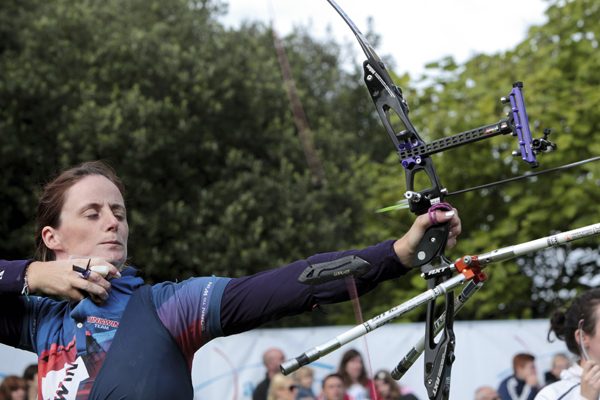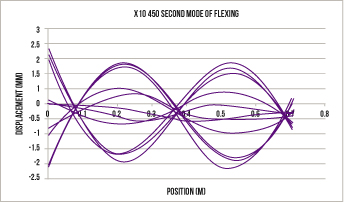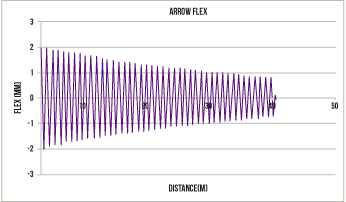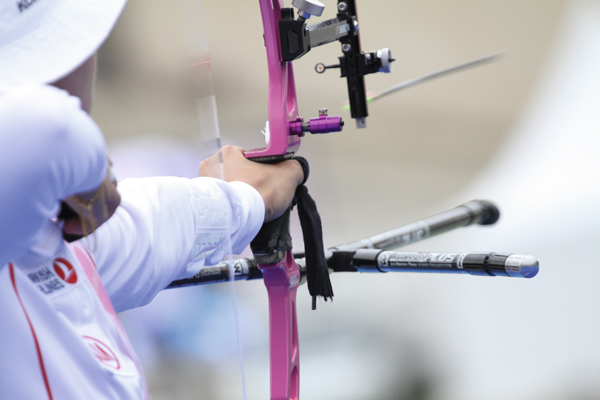James Park begins a series of articles analysing the flex of an arrow in free flight
During the power stroke of a bow the arrow is subjected to very severe forces – the acceleration is around 1000g. Consequently, it is inevitable that the arrow will flex.
Note that when we are tuning the bow we are not trying to minimise the arrow flex. The flex is needed to help the rear of the arrow clear the launcher or pressure button, so we do want the arrow to do it. In tuning the bow we are trying to minimise the arrow’s angle of attack to its direction of forward motion and its longitudinal rotation about its centre of mass – we are trying to line the arrow up with the direction in which it is travelling.
I plan to investigate how the arrow flexes in free flight and, in the future, how it behaves when shot from either a recurve or a compound bow. This was part of the topic of my PhD studies, although I will leave out most of the mathematics – if you want to see the mathematics then it is best to read the papers I had published in the Institute of Mechanical Engineers Journal of Sports Engineering and Technology (go to Google Scholar and do a search under ‘JL Park archery’ and you should find them – but be ready for quite a lot of calculus and partial differential equations).
So, first, we need to understand how an arrow flexes in free flight.
An arrow is quite complicated. The stiffness will vary along the shaft and there are added masses along its length. Both the stiffness and the mass distribution have a substantial impact on how it will flex as will the nature of the forces on it.
An arrow can flex in a number of ‘modes’. The simplest is the ‘first mode’. In the first mode the arrow flexes about two nodes – one near the front of the arrow and one near the rear. Typically, the rear node will be about 150mm along the arrow from the nock and the front node about 60mm along the arrow from the point. The nodes for the first mode of flexing can be found very easily by holding the arrow near the node and plucking the arrow as you would pluck a harp string. If the arrow vibrates for a long time you will be holding it at the node. If the vibrations die out quietly you are not holding it at the node. Figure 1 shows the first mode of flexing for an X10 size 450 and length of 705mm, with a 120-grain point. The rear node was 156mm from the rear of the shaft. The front node was 67mm from the front of the shaft. The calculated frequency of flexing of the first mode was 81Hz.
The second mode of flexing has three nodes. The node positions are different from those for the first mode.
For this arrow, the second mode flexing frequency was 243Hz. That is, the frequency of the second mode is about three times that for the first mode.
The arrow will also flex in higher modes but usually the amplitude of those higher modes will be quite small, so we can ignore them. Typically the amplitude of the second mode of flexing will be about one quarter of that for the first mode of flexing, and as a result the arrow can at times be flexed in an ‘S shape’ – and you can see that S shape in many pictures taken of arrows exiting recurve bows.
Note that it is not possible to hold the arrow at the node for the second mode of flexing and to pluck it as we can for the first mode – we would need to pluck it in two places at once in opposite directions.
The front node for both modes is close to the point because of the high mass of the point. The frequency of flexing of the arrow increases as the shaft stiffness increases, but decreases as the mass increases.
Typically the arrow will flex at frequencies between about 80 and 100Hz for the first mode, so the arrow will flex about once for about every metre of travel in free flight.
The arrow will flex all the way to the target, with the flex amplitude slowly getting smaller, shown in figure 2 (Arrow Flex) for an X10 size 410 with three Titeflight 200 vanes, a 120-grain point and with an initial flex amplitude of 2mm. For this example the flex frequency was 85.5Hz.
Note that changing the point mass does not change the flexing frequency very much: when the point mass was changed to 110 grains the flexing frequency rises to 86.1Hz, and with 100 grains it was 86.8 Hz.
The amplitude of flexing reduces as the arrow travels down range largely due to the lateral movement of the fletching (and the rear taper of the X10 helps).
It is interesting to note that the point shank does not have a major influence on the arrow stiffness. Most of the shaft stiffness comes from the outer layer of carbon fibres and especially those near the middle of the shaft length. Most of the influence of the point on the arrow’s flexing frequency comes from its mass rather than its stiffness contribution.
The arrow’s behaviour when in free flight is quite complicated. During the bow’s power stroke, while the arrow is still on the string, it is even more complicated – but more on that elsewhere!






Wow Nicola, what a great article!
I was intrigued by what happens when you release that arrow the moment I saw the first high-speed camera footage on youtube, I did not imagine it would be that violent.
I looked for the second episode, but I saw the first one was only a month old.. I’m eagerly anticipating a second article on the topic!
I have a question: Do you think an arrow would benefit from flex damping very much? I can imagine that carbon arrows could have a built in dampener if you’d use a low rebound resin in the shaft.
very interesting article, thanks. Am I right in assuming the lighter the shaft the less or lower the frequency would be.As I would have thought the heavier shaft would continue more vibrations over a longer period.